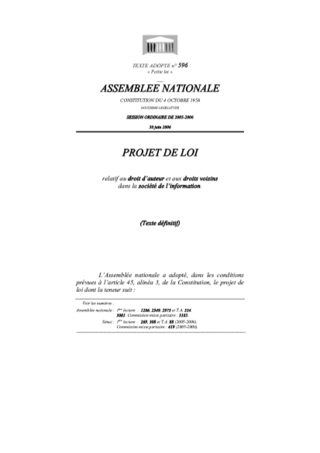A copyright is a type of intellectual property that gives its owner the exclusive right to copy, distribute, adapt, display, and perform a creative work, usually for a limited time. The creative work may be in a literary, artistic, educational, or musical form. Copyright is intended to protect the original expression of an idea in the form of a creative work, but not the idea itself. A copyright is subject to limitations based on public interest considerations, such as the fair use doctrine in the United States.

The World Intellectual Property Organization Copyright Treaty is an international treaty on copyright law adopted by the member states of the World Intellectual Property Organization (WIPO) in 1996. It provides additional protections for copyright to respond to advances in information technology since the formation of previous copyright treaties before it. As of August 2021, the treaty has 110 contracting parties. The WCT and WIPO Performances and Phonograms Treaty, are together termed WIPO "internet treaties".
The Berne three-step test is a clause that is included in several international treaties on intellectual property. Signatories of those treaties agree to standardize possible limitations and exceptions to exclusive rights under their respective national copyright laws.
The copyright law of the European Union is the copyright law applicable within the European Union. Copyright law is largely harmonized in the Union, although country to country differences exist. The body of law was implemented in the EU through a number of directives, which the member states need to enact into their national law. The main copyright directives are the Copyright Term Directive, the Information Society Directive and the Directive on Copyright in the Digital Single Market. Copyright in the Union is furthermore dependent on international conventions to which the European Union or their member states are part of, such as TRIPS Agreement or the Berne Convention.
Ripping is extracting all or parts of digital content from a container. Originally, it meant to rip music out of Commodore 64 games. Later, the term was used to extract WAV or MP3 format files from digital audio CDs, but got applied as well to extract the contents of any media, including DVD and Blu-ray discs, and video game sprites.
Anti-circumvention refers to laws which prohibit the circumvention of technological barriers for using a digital good in certain ways which the rightsholders do not wish to allow. The requirement for anti-circumvention laws was globalized in 1996 with the creation of the World Intellectual Property Organization's Copyright Treaty.
The Rome Convention for the Protection of Performers, Producers of Phonograms and Broadcasting Organisations also known as the International Convention for the Protection of Performers, Producers of Phonograms and Broadcasting Organisations and the Rome Convention, 496 U.N.T.S 43, was accepted by members of the United International Bureaux for the Protection of Intellectual Property (BIRPI), the predecessor to the modern World Intellectual Property Organization, on 26 October 1961. The Diplomatic Conference was jointly convened by BIRPI, the International Labour Organisation, and the United Nations Educational, Scientific and Cultural Organization. The agreement extended copyright related rights protection for the first time to entities or individuals who are not the author but have a close relationship to a copyrighted work, including performers, sound recording producers and broadcasting organizations. As of August 2021, the treaty has 96 contracting parties, with a party defined as a State which has consented to be bound by the treaty and for which the treaty is in force.
Copyright in the Netherlands is governed by the Dutch Copyright Law, copyright is the exclusive right of the author of a work of literature or artistic work to publish and copy such work.

Loi DADVSI is the abbreviation of the French Loi relative au droit d’auteur et aux droits voisins dans la société de l’information. It is a bill reforming French copyright law, mostly in order to implement the 2001 Information Society Directive, which in turn implements a 1996 WIPO treaty.
In copyright law, related rights are the rights of a creative work not connected with the work's actual author. It is used in opposition to the term "authors' rights". Neighbouring rights is a more literal translation of the original French droits voisins. Both authors' rights and related rights are copyrights in the sense of English or U.S. law.

Directive 92/100/EEC is a European Union directive in the field of copyright law, made under the internal market provisions of the Treaty of Rome. It creates a "rental and lending right" as a part of copyright protection, and sets out minimum standards of protection for the related rights of performers, phonogram and film producers and broadcasting organizations.

The Copyright and Related Rights Regulations 2003 transpose the Information Society Directive "(Directive 2001/29/EC of the European Parliament and of the Council of 22 May 2001 on the harmonisation of certain aspects of copyright and related rights in the information society)",, into United Kingdom law. As such, its main effects are to modify the Copyright, Designs and Patents Act 1988 c. 48 with minor consequential modifications to other Acts and secondary legislation.

Directive 98/71/EC of the European Parliament and of the Council of 13 October 1998 on the legal protection of designs is a European Union directive in the field of industrial design rights, made under the internal market provisions of the Treaty of Rome. It sets harmonised standards for eligibility and protection of most types of registered design.
The rule of the shorter term, also called the comparison of terms, is a provision in international copyright treaties. The provision allows that signatory countries can limit the duration of copyright they grant to foreign works under national treatment to no more than the copyright term granted in the country of origin of the work.

Freedom of panorama (FOP) is a provision in the copyright laws of various jurisdictions that permits taking photographs and video footage and creating other images of buildings and sometimes sculptures and other art works which are permanently located in a public place, without infringing on any copyright that may otherwise subsist in such works, and the publishing of such images. Panorama freedom statutes or case law limit the right of the copyright owner to take action for breach of copyright against the creators and distributors of such images. It is an exception to the normal rule that the copyright owner has the exclusive right to authorize the creation and distribution of derivative works. The phrase is derived from the German term Panoramafreiheit.

The Berne Convention for the Protection of Literary and Artistic Works, usually known as the Berne Convention, was an international assembly held in 1886 in the Swiss city of Bern by ten European countries with the goal to agree on a set of legal principles for the protection of original work. They drafted and adopted a multi-party contract containing agreements for a uniform, crossing border system that became known under the same name. Its rules have been updated many times since then. The treaty provides authors, musicians, poets, painters, and other creators with the means to control how their works are used, by whom, and on what terms. In some jurisdictions these type of rights are being referred to as copyright.
The WIPO Copyright and Performances and Phonograms Treaties Implementation Act, is a part of the Digital Millennium Copyright Act (DMCA), a 1998 U.S. law. It has two major portions, Section 102, which implements the requirements of the WIPO Copyright Treaty, and Section 103, which arguably provides additional protection against the circumvention of copy prevention systems and prohibits the removal of copyright management information.
Layout designs (topographies) of integrated circuits are a field in the protection of intellectual property.

The Digital Millennium Copyright Act (DMCA) is a 1998 United States copyright law that implements two 1996 treaties of the World Intellectual Property Organization (WIPO). It criminalizes production and dissemination of technology, devices, or services intended to circumvent measures that control access to copyrighted works. It also criminalizes the act of circumventing an access control, whether or not there is actual infringement of copyright itself. In addition, the DMCA heightens the penalties for copyright infringement on the Internet. Passed on October 12, 1998, by a unanimous vote in the United States Senate and signed into law by President Bill Clinton on October 28, 1998, the DMCA amended Title 17 of the United States Code to extend the reach of copyright, while limiting the liability of the providers of online services for copyright infringement by their users.
Copyright in Oman is regulated by the Law for the Protection of Copyright and Neighbouring Rights issued by Royal Decree No 65/2008 which was later amended by Royal Decree No 132/2008.







